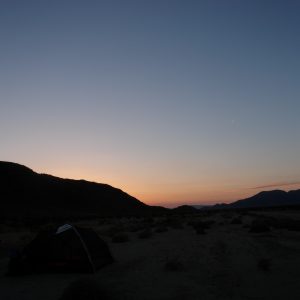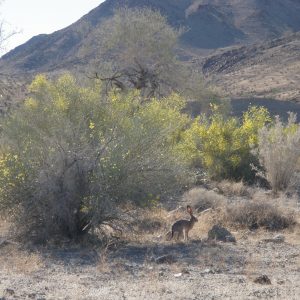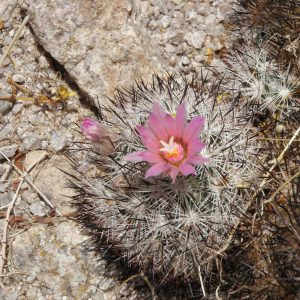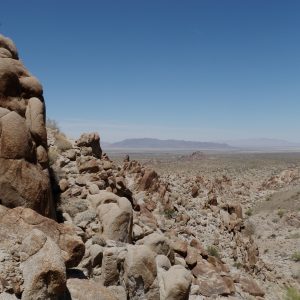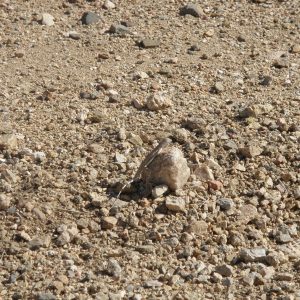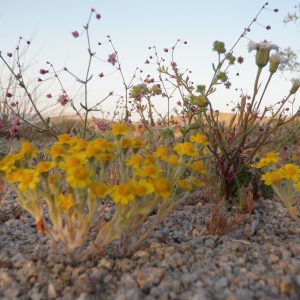I just finished my ninth month working at the Bureau of Land Management in Tucson, Arizona. I moved to Tucson last September to work with the ecosystem planner at Las Cienegas National Conservation Area; located a few miles south of Sonoita, Arizona. I was not prepared for the unrelenting sun and harsh desert landscape that was about to become my home. Las Cienegas is composed of both upland grasslands and mesquite bosques or riparian areas. The native grasses and cacti of the upland grassland are extremely resilient plants as they must be adapted to withstand unpredictable precipitation patterns and blazing temperatures as well as an occasional brush fire. A perennial creek runs through the conservation area making it an ideal habitat for many species of birds, fish and frogs. This rare perennial water source makes Las Cienegas a truly special place in an unforgiving land where water is scarce. People from different organizations and agencies have been working for over twenty years to restore and make this picturesque landscape as resilient as possible in the face of a changing climate.
I jumped head first into this community of conservation and landscape restoration. My mentor and I decided that as one of my internship projects we should start a partnership with the local high school to help these students learn about conservation and land restoration in a changing climate. I started working with these students back in January when we went out Las Cienegas to collect native Sacaton grass seeds. Sacaton is a unique grass that grows in bottoms between the upland grasslands and the mesquite bosques or riparian lowlands. Sacaton bottoms characterize the transition from uplands to the riparian areas. These hearty grasses that are normally taller than me are extremely important in holding the landscape together. During the monsoon season which is characterized by torrential downpours, Sacaton roots that can reach up to five or six feet below the ground play a critical role in preventing all the soil from eroding away and leaving huge scars in the earth. At Las Cienegas; there are disturbing bare areas devoid of Sacaton plants cropping up in the Sacaton bottoms. We decided it would be excellent to start seed saving and growing our own plants to restore these bare areas.
The students liked the idea of created their own Sacaton restoration areas that they could watch for years to come. After we had collected seeds from the Sacaton plants, we planted them in one gallon containers in their classroom. The students watered them and watched them grow for two and half months. Some of the plants that were planted in smaller containers did not fare so well over spring break. Finally in April the students took all of their new Sacaton plants that they had grown from seed and planted them in one bare Sacaton bottom area near the side of the road. I helped the students water the plants during the planting event and strategically used a product called DriWater to help the seedlings survive. I am excited to return to Tucson in the fall to see how the Sacaton plants have fared.
Daily Archives: 1 July, 2011
Wait… I know that genus!
I left my winter wonderland of a home in Minnesota for the desert Southwest in California about three months ago to begin my new Seeds of Success internship. What was to come was uncertain, and I knew I was in for an extreme learning experience in a brand new…everything. And I was right. Almost. My work prior to my CLM Internship was in the prairies and oak savannas of Minnesota. It was daunting to think of all the new plant species, and even new plant families, I would need to learn in the California Desert in order to appropriately monitor sites for seed collections. However, while working in the field, surrounded by an overwhelmingly new landscape, that I realized I knew more than I had thought about the desert plants. I actually recognized plants (!!!), even if just to the genus. Once you think about it, it only makes sense that there would be some parallels between prairie and desert plants. But it was such a great feeling to have familiarity in the unfamiliar. And now, after three months of desert adventures and daily pop quizes in desert botany (most of which I pass), I feel almost at home in this new landscape. Almost.
Again? OK!
“You haven’t experienced Wyoming until you have lived through a Wyoming winter.” That is the message that everyone in my field office kept telling me last year. Well, I got the chance to do so. A few weeks before my internship had ended last fall, the lead wildlife biologist had offered me to come back to the Kemmerer Field Office as a wildlife intern from February through July. He had explained to me that I would have a variety of projects, but most importantly, the office needed more data on the winter habitat for the Greater Sage Grouse. I would be out in the field during the winter mapping pockets of sage brush that were above the snowline along with mapping perimeters of the leks (areas where the grouse group together to mate) and lek surveys in the field office. There would be cold temperatures and 3:30 am wake ups. (Sounds enticing doesn’t it?) Still, I couldn’t pass up another amazing opportunity like this. I got used to the extreme cold temperatures (mornings of -15 degrees) and the gorgeous early morning sunrises. I had a great time snow shoeing and snowmobiling in the back country of Wyoming-things people pay to do…and I was getting paid to do it. After many cold days outside and long days at the computer, I have recently finished the GIS analysis of roughly 3 months worth of data and I helped the office go from 0 acres to over 130,000 acres of mapped winter sage grouse habitat. I am glad it is finally warming up. When the landscape dries out I will be mapping Mountain Plover habitat, conducting Mountain Plover and Burrowing Owl surveys, as well as checking up on raptor nests. I cannot wait! I am thoroughly pleased that I came back!
Larry Ashton
Kemmerer, WY BLM
BLM Palm Springs, CA
My name is Vince and I have been a CLM intern for about 3 months. It had definitely been a bumpy ride getting used to a new life. I moved from South Carolina to Palm Springs, CA, and I have never lived anywhere other than South Carolina before, so this was definitely a change for me. I work at the BLM South Coast Field Office working on the Dos Palmas Project.
Dos Palmas is a preserve that was created by the Coachella Canal, the Canal was lined and is no longer providing water to several Palm Oases in this preserve. Basically, my job is to help restore these Palm Oases by planting existing vegetation that is no longer growing there because of the lack of water.
This experience has been great and I love it out here. I have met several amazing people and made friends; I hope to stay in contact with. I have also learned quite a bit during my internship. I took a course on GIS, something that everyone seems to know and now I do too. I have learned several different desert plant species, and seen several different desert animals.
The summer is finally approaching and today the high was 115 degrees, sweet, I survived it! Hopefully I will be able to survive all of it, I am sure it will be a challenge that I have yet to conquer.
I found this oasis on one of my first visits to Dos Palmas! This is an awesome place.

